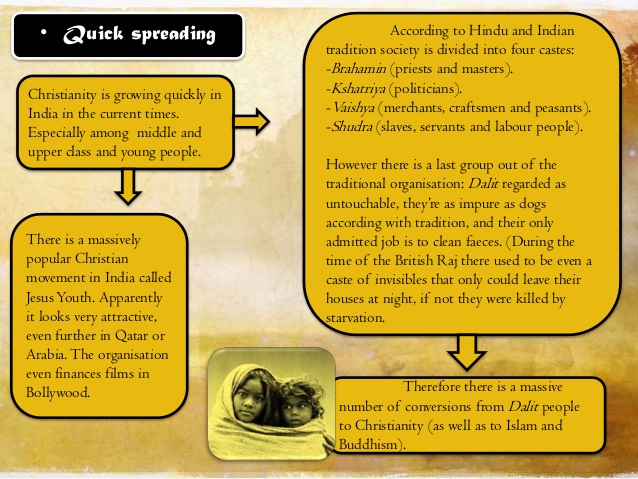Christian Impact On India – Anthropology Notes – For W.B.C.S. Examination.
ভারতে খ্রিস্টান প্রভাব – নৃ তত্ব নোট – WBCS পরীক্ষা।
CHRISTIAN IMPACT ON INDIA, HISTORY OF It is widely believed that St. Thomas, the disciple of Jesus, first introduced the Christian faith to India nearly two thousand years ago. The subcontinent would not experience the influence of Christianity, however, until the much later arrival of the Europeans. The Portuguese began to settle in Goa from 1498. In 1542 the Jesuit Francis Xavier, a papal ambassador, arrived, and the work of the Roman Catholics began in earnest. Protestant ministry in India was first established in Tranquebar by two German pietists, Bartholomew Ziegenbalg and Henry Plutschau.Continue Reading Christian Impact On India – Anthropology Notes – For W.B.C.S. Examination.
Education
Christian missionary activity in India generally involved the establishment of high-quality schools. Obviously the Christian community’s impact does not end there. Accompanying the schools came printing presses, which were helpful in the dissemination of literature of all kinds. In fact, the early overseas missionaries were responsible for pioneering English and modern vernacular education. R. L. Rawat, in his History of Indian Education, suggests that India will forever be indebted to the missionaries for the production of textbooks, dictionaries, and grammars, and for their zealous pursuit of educational advancement.
The “good works” carried out by missionaries and Christians have always been understood to be an expression of their love and obedience to Jesus. The underlying motivation, of course, was their obligation to proclaim the salvation of God through the Christian faith. Indians have by and large been willing to receive the former, but many have rejected the need for the latter, particularly upper caste Hindus, who would say, “we have our own saviors.” Still, the Christian community has felt that it has contributed to the building of the nation and to an upward social mobility that has changed lives and benefited families and communities, particularly among the Dalits (the former “untouchables”).
In the sixteenth century it was the Jesuits who first established Christian institutions of learning. They were followed by the German Tranquebar missionaries. Later the renowned Friedrick Schwartz began Christian schools in both vernacular languages and in English. William Carey and the British Baptists who arrived in Calcutta in the late eighteenth century pioneered modern education in North India. By 1818 there were 111 schools located as far away from Calcutta as Shimla and Delhi in the north, and Rajputna in the south.
Language and Literature
Christians have also made a significant contribution in India in the fields of languages, literature, and journalism. Constanzio Beschi (1680–1747) reformed Tamil alphabetical characters, making them more suitable for the printing press. He also produced a fourfold Tamil dictionary, which was divided according to words, synonyms, classes, and rhymes. Bishop Robert Caldwell’s (1815–1891) Comparative Grammar of the Dravidian Languages and G. U. Pope’s (1820–1908) translations of classics of Tamil literature into English are noteworthy. Vedanayagam Pillai (1824–1889) and H. A. Krishna Pillai (1827–1900) are two other Christian writers who produced some of the first Tamil novels.
The French priest Francis Mary of Toure began work on Hindustani as early as 1680, composing a massive dictionary titled Thesaurus Linguae Indianae. Modern Hindi, the national language, developed out of Hindustani. Henry Martyn and a Dr. Gilchrist, a professor of Hindustani and an American Presbyterian missionary, and the Reverend S. H. Kellogg all contributed to the formation and popularization of Hindustani. Kellogg, in fact, drew more than a dozen dialects together to assist in creating what is today known as Hindi. He produced in 1893 A Grammar of the Hindi Language, which is still in circulation. William Carey and his Baptist colleagues, beginning in 1818, were the first to produce periodicals, journals, and a newspaper. Their publication, the Friends of India, lived on and is now an English daily, the Statesman, published from Calcutta and New Delhi.
Social Reform
From the very first, missionaries were shocked at the social evils that persisted in India, including the practice of sati (the immolation of widows on their husbands’ funeral pyres), the killing of lepers, and the sacrifice of children.
William Carey was active from his arrival in 1793 in any issue that he felt needed change or reform. Within a year, near Malda, he reported having found the remains of an infant that had first been offered to a god as a sacrifice and then abandoned to be eaten by white ants. Moreover, children were thrown into the Ganges in fulfillment of vows taken for answers to prayer. Carey used his connections to those in authority and power to campaign for the outlawing of such practices. Governor-General Lord Wellesley asked him to submit a report on the matter and subsequently, in 1802, declared infanticide to be an act of murder; those who performed such horrible deeds, if caught, would themselves be put to death.
Carey employed his publications to educate public opinion on matters of humanitarian concern. The first issue of the Friend of India carried an exhaustive report of an actual sati. Subsequently he kept the practice before the public eye and did all he could to see sati abolished. By 1814 Ram Mohan Roy joined Carey in the campaign against sati. Armed with accounts of 438 widow burnings, Carey and his Serampre colleagues implored the government to forbid the rite by law. At first very little progress was made, due to strong opposition from high caste Hindu leaders. The Christians kept up the pressure, and eventually public opinion turned against the orthodox Hindus. In 1829 Lord William Bentinck finally signed an order prohibiting sati in the occupancies of the East India Company.
For Guidance of WBCS (Exe.) Etc. Preliminary , Main Exam and Interview, Study Mat, Mock Test, Guided by WBCS Gr A Officers , Online and Classroom, Call 9674493673, or mail us at – mailus@wbcsmadeeasy.in
Visit our you tube channel WBCSMadeEasy™ You tube Channel
Please subscribe here to get all future updates on this post/page/category/website



 +919674493673
+919674493673  mailus@wbcsmadeeasy.in
mailus@wbcsmadeeasy.in






































































































